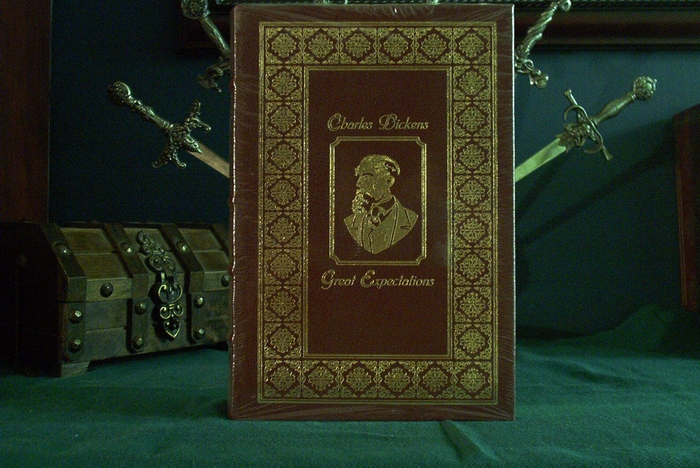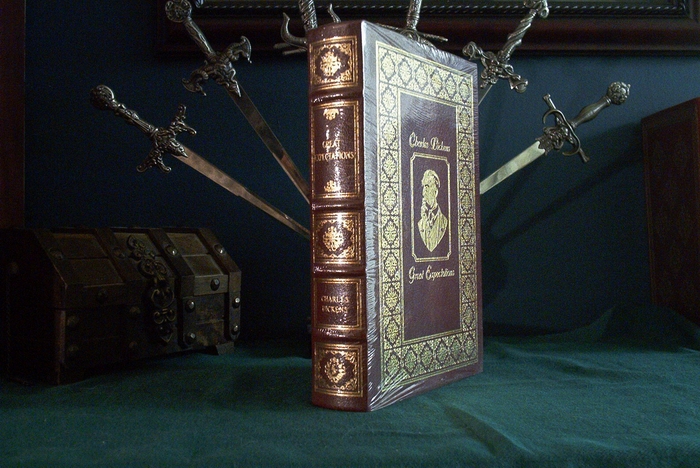Easton Press Charles Dickens books
The Pickwick Papers - The Collector's Library of Famous Editions - 1964
Hard Times - The Collector's Library of Famous Editions - 1966
A Christmas Carol - 1967
Oliver Twist -1967
Life and Adventures of Nicholas Nickleby - The Collector's Library of Famous Editions - 1968
The Old Curiosity Shop - The Collector's Library of Famous Editions - 1968
Barnaby Rudge - 1969
The Mystery of Edwin Drood -1969
Bleak House - 1970
The Short Stories - 100 Greatest Books Ever Written - 1978
David Copperfield - 100 Greatest Books Ever Written - 1979
Great Expectations - 100 Greatest Books Ever Written - 1979
A Tale of Two Cities - 100 Greatest Books Ever Written - 1981
Little Dorrit - 1984
The Chimes - The Collector's Library of Famous Editions - 1991
Life and Adventures of Martin Chuzzlewit - 1993
Franklin Library Charles Dickens books
Great Expectations - 100 Greatest Books of All Time - 1977
Great Expectations - World's Best Loved Books - 1977
Three Christmas Stories - World's Best Loved Books - 1980
Three Christmas Stories - Collected Stories of the World's Greatest Writers - 1984
A Tale of Two Cities - World's Best Loved Books - 1985
The Mystery of Edwin Drood - Library of Mystery Masterpieces - 1988
Works of Charles Dickens in 24 Volumes - The Oxford Library of Charles Dickens (quarter bound) - 1982, 1983, 1984, 1985
(This page contains affiliate links for which we may be compensated.)
Charles Dickens biography
Great Expectations
The Pickwick Papers
Few first novels have created as much popular excitement as The Pickwick Papers a comic masterpiece that catapulted its 24-year-old author to immediate fame. Readers were captivated by the adventures of the poet Snodgrass, the lover Tupman, the sportsman Winkle &, above all, by that quintessentially English Quixote, Mr Pickwick, & his cockney Sancho Panza, Sam Weller. From the hallowed turf of Dingley Dell Cricket Club to the unholy fracas of the Eatanswill election, via the Fleet debtor’s prison, characters & incidents sprang to life from Dickens’s pen, to form an enduringly popular work of ebullient humour & literary invention.David Copperfield
A Tale of Two Cities
A Tale of Two Cities is Charles Dickens’s great historical novel, set against the violent upheaval of the French Revolution. The most famous and perhaps the most popular of his works, it compresses an event of immense complexity to the scale of a family history, with a cast of characters that includes a bloodthirsty ogress and an antihero as believably flawed as any in modern fiction. Though the least typical of the author’s novels, A Tale of Two Cities still underscores many of his enduring themes imprisonment, injustice, social anarchy, resurrection, and the renunciation that fosters renewal.The Mystery of Edwin Drood
Edwin Drood is contracted to marry orphan Rosa Bud when he comes of age, but when they find that duty has gradually replaced affection, they agree to break off the engagement. Shortly afterwards, in the middle of a storm on Christmas Eve, Edwin disappears, leaving nothing behind but some personal belongings and the suspicion that his jealous uncle John Jasper, madly in love with Rosa, is the killer. And beyond this presumed crime there are further intrigues: the dark opium dens of the sleepy cathedral town of Cloisterham, and the sinister double life of Choirmaster Jasper, whose drug-fuelled fantasy life belies his respectable appearance. Dickens died before completing The Mystery of Edwin Drood, leaving its tantalising mystery unsolved and encouraging successive generations of readers to turn detective.A Christmas Carol
To bitter, miserly Ebenezer Scrooge, Christmas is just another day. But all that changes when the ghost of his long-dead business partner appears, warning Scrooge to change his ways before it's too late."If I had my way, every idiot who goes around with Merry Christmas on his lips, would be boiled with his own pudding, and buried with a stake of holly through his heart. Merry Christmas? Bah humbug!"
Oliver Twist
The story of Oliver Twist orphaned, and set upon by evil and adversity from his first breath shocked readers when it was published. After running away from the workhouse and pompous beadle Mr Bumble, Oliver finds himself lured into a den of thieves peopled by vivid and memorable characters the Artful Dodger, vicious burglar Bill Sikes, his dog Bull's Eye, and prostitute Nancy, all watched over by cunning master-thief Fagin. Combining elements of Gothic Romance, the Newgate Novel and popular melodrama, Dickens created an entirely new kind of fiction, scathing in its indictment of a cruel society, and pervaded by an unforgettable sense of threat and mystery.Hard Times
"My satire is against those who see figures and averages, and nothing else," proclaimed Charles Dickens in explaining the theme of this classic novel. Published in 1854, the story concerns one Thomas Gradgrind, a "fanatic of the demonstrable fact," who raises his children, Tom and Louisa, in a stifling and arid atmosphere of grim practicality.
Without a moral compass to guide them, the children sink into lives of desperation and despair, played out against the grim background of Coketown, a wretched community shadowed by an industrial behemoth. Louisa falls into a loveless marriage with Josiah Bouderby, a vulgar banker, while the unscrupulous Tom, totally lacking in principle, becomes a thief who frames an innocent man for his crime. Witnessing the degradation and downfall of his children, Gradgrind realizes that his own misguided principles have ruined their lives.
Considered Dickens' harshest indictment of mid-19th-century industrial practices and their dehumanizing effects, this novel offers a fascinating tapestry of Victorian life, filled with the richness of detail, brilliant characterization, and passionate social concern that typify the novelist's finest creations.
Of Dickens' work, the eminent Victorian critic John Ruskin had this to say: "He is entirely right in his main drift and purpose in every book he has written; and all of them, but especially Hard Times, should be studied with close and earnest care by persons interested in social questions."
Nicholas Nickleby
When Nicholas Nickleby is left penniless after his father's death, he appeals to his wealthy uncle to help him find work and to protect his mother and sister. But Ralph Nickleby proves both hard-hearted and unscrupulous, and Nicholas finds himself forced to make his own way in the world. His adventures gave Dickens the opportunity to portray an extraordinary gallery of rogues and eccentrics: Wackford Squeers, the tyrannical headmaster of Dotheboys Hall, a school for unwanted boys; the slow-witted orphan Smike, rescued by Nicholas; and the gloriously theatrical Mr and Mrs Crummles and their daughter, the 'infant phenonenon'. Like many of Dickens's novels, Nicholas Nickleby is characterised by his outrage at cruelty and social injustice, but it is also a flamboyantly exuberant work, revealing his comic genius at its most unerring.
The Old Curiosity Shop
Little Nell Trent lives in the quiet gloom of the old curiosity shop with her ailing grandfather, for whom she cares with selfless devotion. But when they are unable to pay their debts to the stunted, lecherous and demonic money-lender Daniel Quilp, the shop is seized and they are forced to flee, thrown into a shadowy world in which there seems to be no safe haven. Dickens's portrayal of the innocent, tragic Nell made The Old Curiosity Shop an instant bestseller that captured the hearts of the nation, even as it was criticised for its sentimentality by figures such as Oscar Wilde. Yet alongside the story's pathos are some of Dickens's greatest comic and grotesque creations: the ne'er-do-well Dick Swiveller, the mannish lawyer Sally Brass, the half-starved 'Marchioness' and the lustful, loathsome Quilp himself.
Barnaby Rudge
Charles Dickens’s first historical novel–set during the anti-Catholic riots of 1780 is an unparalleled portrayal of the terror of a rampaging mob, seen through the eyes of the individuals swept up in the chaos.
Those individuals include Emma, a Catholic, and Edward, a Protestant, whose forbidden love weaves through the heart of the story; and the simpleminded Barnaby, one of the riot leaders, whose fate is tied to a mysterious murder and whose beloved pet raven, Grip, embodies the mystical power of innocence. The story encompasses both the rarified aristocratic world and the volatile streets and nightmarish underbelly of London, which Dickens characteristically portrays in vivid, pulsating detail. But the real focus of the book is on the riots themselves, depicted with an extraordinary energy and redolent of the dangers, the mindlessness, and the possibilities–both beneficial and brutal–of the mob.
One of the lesser-known novels, Barnaby Rudge is nonetheless among the most brilliant–and most terrifying in Dickens’s oeuvre.
Bleak House
Bleak House opens in the twilight of foggy London, where fog grips the city most densely in the Court of Chancery. The obscure case of Jarndyce and Jarndyce, in which an inheritance is gradually devoured by legal costs, the romance of Esther Summerson and the secrets of her origin, the sleuthing of Detective Inspector Bucket and the fate of Jo the crossing-sweeper, these are some of the lives Dickens invokes to portray London society, rich and poor, as no other novelist has done. Bleak House, in its atmosphere, symbolism and magnificent bleak comedy, is often regarded as the best of Dickens. A 'great Victorian novel', it is so inventive in its competing plots and styles that it eludes interpretation.
Little Dorrit
When Arthur Clennam returns to England after many years abroad, he takes a kindly interest in Amy Dorrit, his mother's seamstress, and in the affairs of Amy's father, William Dorrit, a man of shabby grandeur, long imprisoned for debt in Marshalsea prison. As Arthur soon discovers, the dark shadow of the prison stretches far beyond its walls to affect the lives of many, from the kindly Mr Panks, the reluctant rent-collector of Bleeding Heart Yard, and the tipsily garrulous Flora Finching, to Merdle, an unscrupulous financier, and the bureaucratic Barnacles in the Circumlocution Office. A masterly evocation of the state and psychology of imprisonment, Little Dorrit is one of the supreme works of Dickens's maturity.
The Chimes
The Chimes is Charles Dickens 1844 novella that concerns the disillusionment of Toby "Trotty" Veck, a poor working-class man. When Trotty has lost his faith in Humanity and believes that his poverty is the result of his unworthiness he is visited on New Year's Eve by spirits to help restore his faith and show him that nobody is born evil, but rather that crime and poverty are things created by man.
Martin Chuzzlewit
While writing Martin Chuzzlewit, his sixth novel, Dickens declared it 'immeasurably the best of my stories.' He was already famous as the author of The Pickwick Papers and Oliver Twist.
Set partly in America, which Dickens had visited in 1842, the novel includes a searing satire on the United States. Martin Chuzzlewit is the story of two Chuzzlewits, Martin and Jonas, who have inherited the characteristic Chuzzlewit selfishness. It contrasts their diverse fates of moral redemption and worldly success for one, with increasingly desperate crime for the other. This powerful black comedy involves hypocrisy, greed and blackmail, as well as the most famous of Dickens's grotesques, Mrs Gamp.

